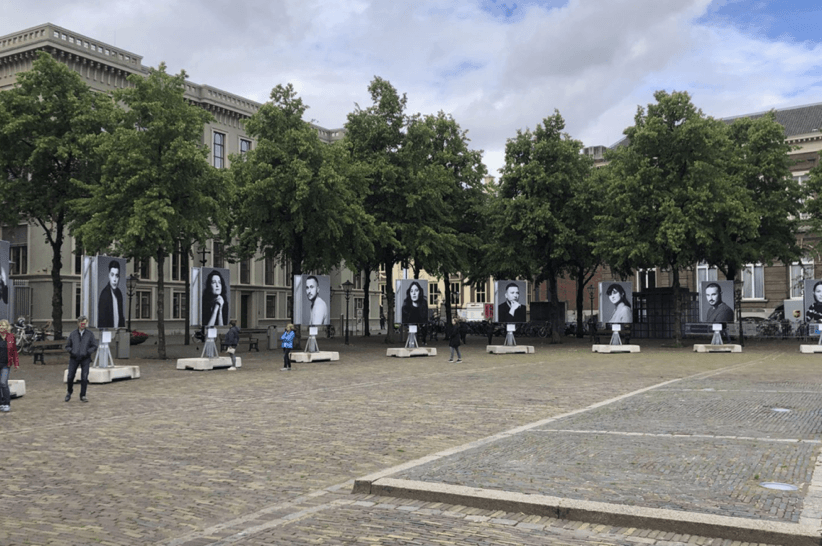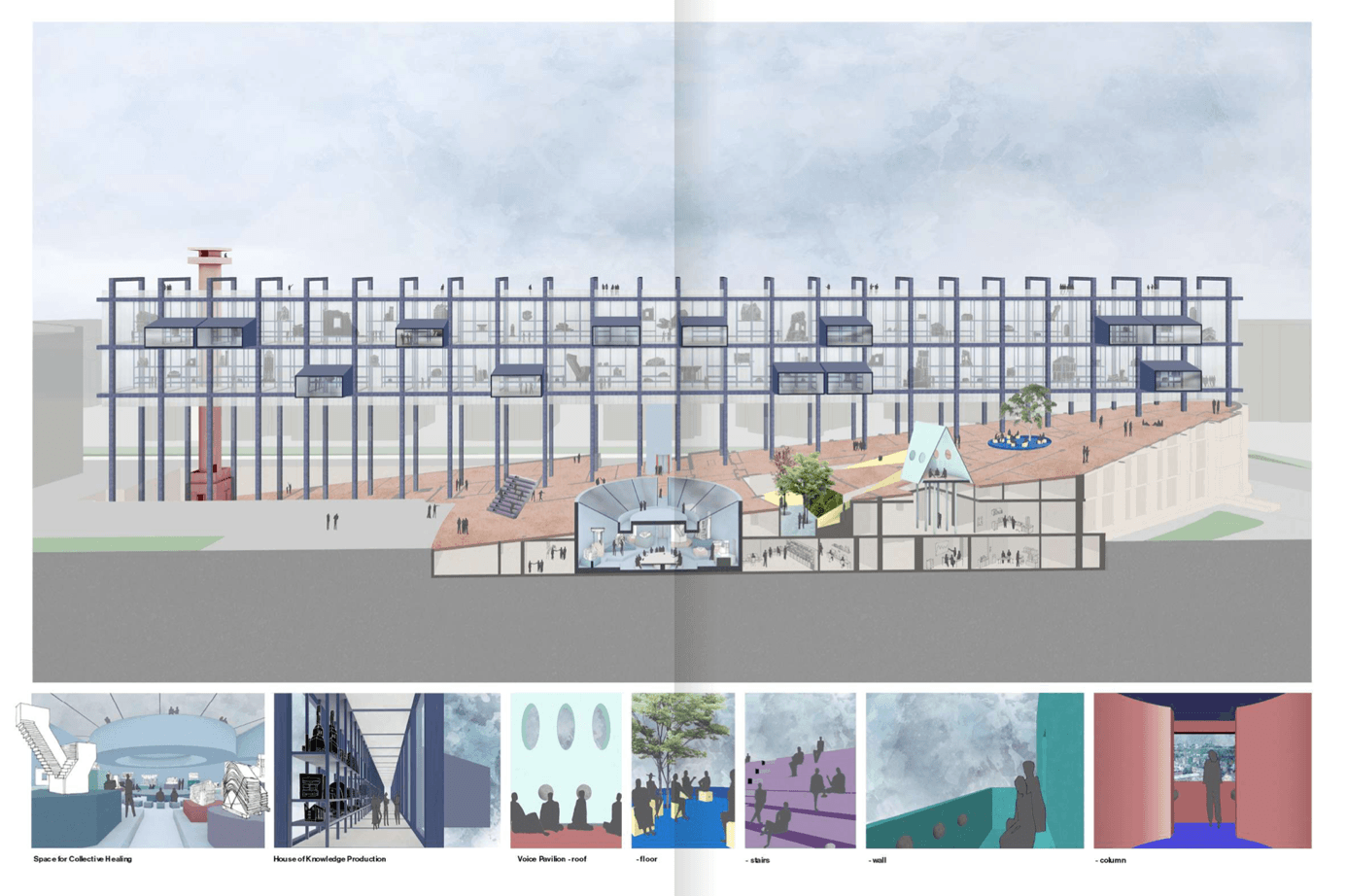Interview Arna Mačkić-Srebrenica is Dutch history

- Anna Odink
On July 11, 2020, it was exactly 25 years ago that the genocide in Srebrenica took place. More than 8,000 Bosnian Muslim men and boys were killed, and the Dutch UN battalion Dutchbat was supposed to protect them. It is the largest genocide in Europe since World War II.
During the 25th Srebrenica commemoration in 2020, the Mayor of The Hague, Jan van Zanen, announced that a memorial monument for the victims of the Srebrenica genocide would be established. Shortly thereafter, Mačkić, along with the Bosnian Girl collective, unveiled the temporary monument Srebrenica is Dutch History. It is a campaign drawing attention to the Srebrenica genocide, the role of the Netherlands, and the 25-year commemoration in the country.
Mačkić: “I used to attend the Srebrenica commemoration on the ‘square’ in The Hague every year. I, and the other members of Bosnian Girl, noticed a lack of interest in the commemoration. With the Bosnian Girl collective, we wanted to launch a campaign to make many more people aware that this is not just Bosnian history but also a Dutch one. The dominant story in the media mainly focuses on the Dutchbatters, the Dutch soldiers who were in Srebrenica. On their experiences, pain, and trauma. The Bosnian Dutch people, or those who survived Srebrenica, have their own story. That story is less dominant and therefore less heard."
Photographer Robin de Puy took 25 photos of 25-year-old Bosnian-Dutch youngsters. All have Bosnian roots but were born or raised in the Netherlands. Through their dual identity, they symbolize the connection between Dutch and Bosnian history. The temporary monument consists of a circular arrangement of the 25 portrait photos on the ‘square’. Within this circle, the physical commemoration took place, after which the temporary monument remained in place for three weeks. Afterward, the temporary monument went on a tour and was exhibited in various Dutch cities such as Amsterdam, Haarlem, and Rotterdam.
Mačkić continues: “The temporary monument generated a lot of positive energy. It showed what a physical monument can add and mean. The government in The Hague decided that a national monument should be established, but that was the merit of the committee that has been organizing the commemoration for years. The Mayor of Rotterdam expressed his willingness to contribute financially to the national monument, and the Chief Government Architect (Rijksbouwmeester) got involved in the discussion."
The temporary monument Srebrenica is Dutch history on the ‘square’ in The Hague, Studio L A, 2020
The Hague Department of Monuments indicated in early 2023 that they are examining the achievability of a national memorial.
Why is the realization of the definitive monument taking so long?
“The Bosnian community would like the monument to be next to the former Yugoslavia Tribunal, but within this zone, everything revolves around safety, it is a very controlled area. It is complex to realize a monument there because many people will come, and that requires good coordination. The government has decided that it is a potential location for the monument, but I don't think a final decision has been made yet," says Mačkić.
A new place for gathering
The theme of Prix de Rome Architecture (2022) was 'Healing Sites.' Mačkić designed a Public Centre for Architectural Disaster & Collective Healing. The proposal advocates for the establishment of a new international institute that could replace the former Yugoslavia Tribunal.
Is this architectural work also a place for commemoration?
“In this work, I use the term 'architectural disaster.' By this, I mean that through intervention with architecture or through intervention in existing architecture, human and ecological relationships are disrupted and destroyed." According to Mačkić, we can think of the damage to nature and homes caused by gas extraction in Groningen. Other examples that Mačkić mentions are the destruction caused by the war in Ukraine, the lack of humane housing for refugees, or the demolition of social rental homes in cities.
"As (landscape) architects or urban planners, we often position ourselves neutrally, thinking that the causes of these disasters are beyond our control. But where architecture is involved in disasters, our responsibility to relate to these disasters begins immediately. Because if architectural disaster is caused by intervening with or in architecture, it can also achieve the opposite: connecting and building human and ecological relationships."
According to Mačkić, the institute attempts to bring together these human and ecological relationships. “Cases of architectural disaster are examined. The victims, those responsible, and the involved communities of the architectural disaster come together, guided by a team of researchers and mediators, to undergo a healing process. The institute is both a reconciliation and a break with the existing building where the Yugoslavia Tribunal was housed. The building is intersected and transformed into a large ascending square that provides insight into the former function of the tribunal. On the square is the new program, consisting of pavilions where those involved can share their stories. I also designed a hall where contextual mediation takes place between those involved, and a knowledge center where architects and other experts can work on spatial proposals to repair the damage. I don't necessarily see it as a place for commemoration. For many Bosnians, the former Yugoslavia Tribunal had a lot of emotional value, and I do integrate that into my design."
About Arna Mačkić-Srebrenica
Arna Mačkić is an architect and founded, together with Lorien Beijaert, Studio L A. For the Prix de Rome Architecture 2022, Mačkić designed a new institute in The Hague, partially replacing the building that housed the International Tribunal for the former Yugoslavia. Mačkić is also part of the Bosnian Girl Collective, a group of four Bosnian-Dutch women who continue to draw attention to Srebrenica.
Arna Mačkić, ontwerp Public Centre for Architectural Disaster & Collective Healing, Prix de Rome Architecture 2022

